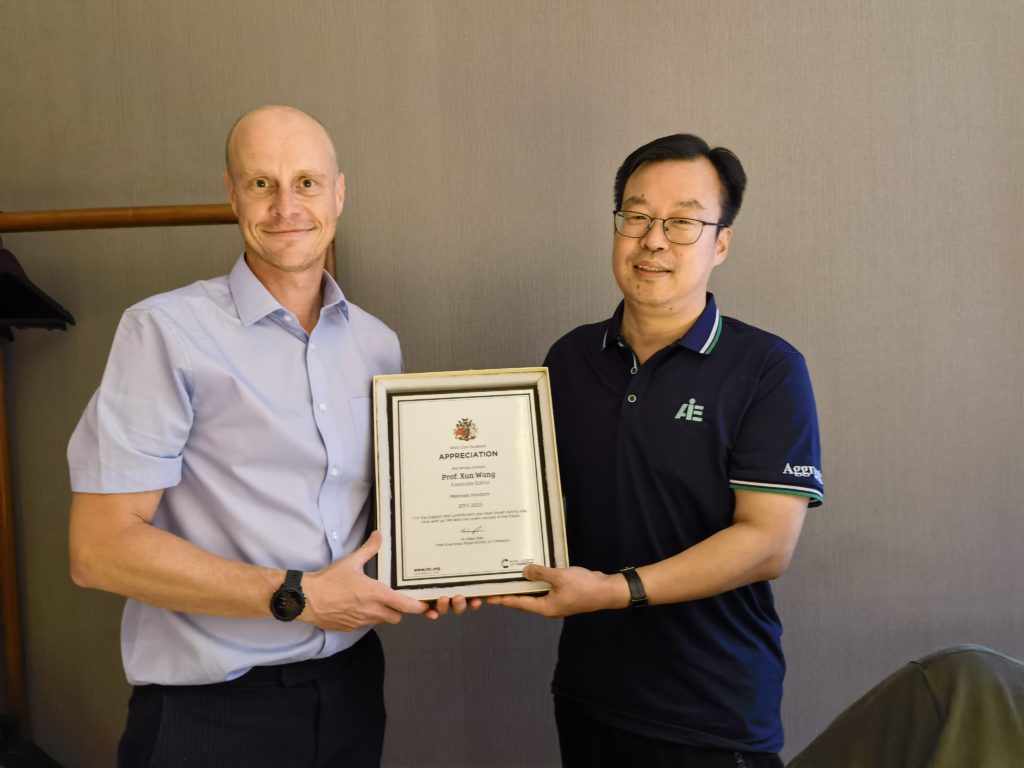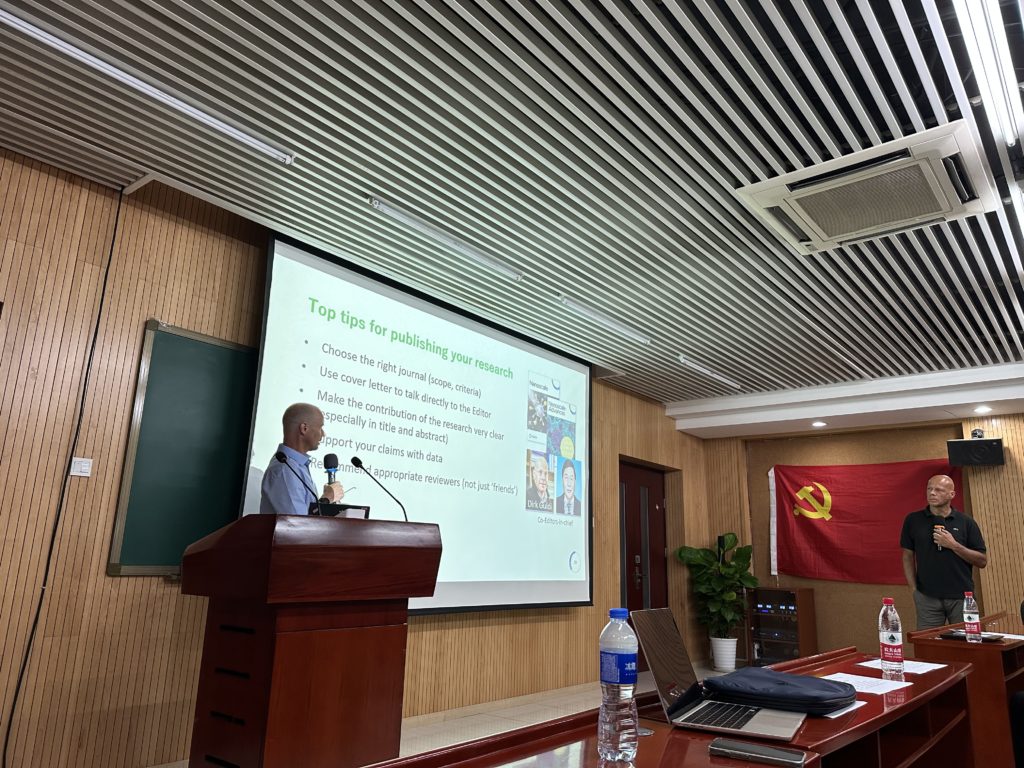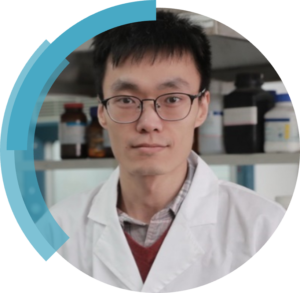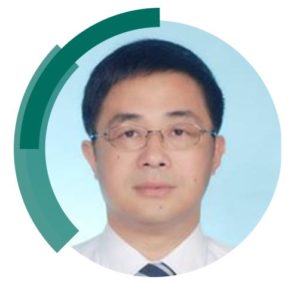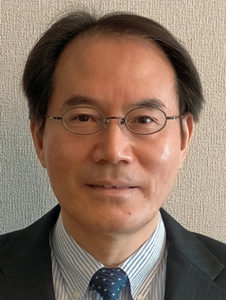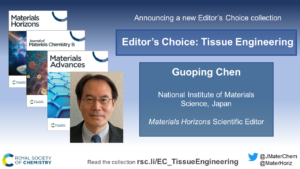Professor Xun Wang, former Scientific Editor of Materials Horizons, was presented with a certificate of appreciation by Publisher Neil Hammond on 30 August (above photo). The certificate was given at a dinner after a visit to Tsinghua University, China. Professor Quanming Wang, the Vice Dean of the Chemistry department, hosted the visit to Tsinghua University and chaired the talks. Nanoscale Horizons Scientific Editor Dirk Guldi presented the scientific talk followed by a joint publishing talk with Publisher Neil Hammond (below photo).
Materials Horizons 10th Anniversary ‘Community Spotlight’ – Meet our Emerging Investigators Part 2
Introducing Materials Horizons’ Emerging Investigators 2020/2021 – Part 2.
This year we are pleased to celebrate the tenth anniversary of Materials Horizons. We are so grateful to our fantastic community of authors, reviewers, Board members and readers and wanted to showcase just some of them in a series of ‘Community Spotlight’ blog articles.
In our second ‘Community Spotlight’, we feature some of our past ‘Emerging Investigators’ who have contributed their outstanding research to Materials Horizons.
Our Emerging Investigators series highlights early career scientists who have excelled in their field and work to provide quality research and communications in order to contribute to the constant evolution of chemical sciences. We asked some of our past Emerging Investigators about their experience as up-and-coming researchers and how their work has developed from early career stage to now. Check out their interview responses below.
Eleni Stavrinidou, Emerging Investigator 2021Linköping University, Sweden |
Eleni Stavrinidou is an Associate Professor and leader of the Electronic Plants group at Linköping University. She received a PhD in Microelectronics from EMSE (France) in 2014. She then did her postdoctoral training at Linköping University (Sweden) during which she was awarded a Marie Curie fellowship. In 2017 Eleni Stavrinidou became Assistant Professor in Organic Electronics at Linköping University and established the Electronic Plants group. She received several grants including a Swedish Research Council Starting Grant and a FET-OPEN grant which she was the coordinator. In 2020 she became Associate Professor and Docent in Applied Physics. The same year she was awarded the Future Research Leaders grant of the Swedish Foundation for Strategic Research. In 2021 she was awarded the ERC-Staring Grant. Stavrinidou is recipient of the L’ORÉAL-UNESCO For Women in Science prize in Sweden (2019) and the Tage Erlander Prize for Natural Sciences and Technology from the Royal Swedish Academy of Sciences (2023). Her research interests focus on plant bioelectronics for real time monitoring and dynamic control of plant physiology and plant-based biohybrid systems for energy and sensing applications.
What inspired you to pursue a career in your specific field of research?
“I am fascinated by the potential of interfacing technological systems with biology to solve societal problems but also for pure scientific curiosity. Biological systems are beautiful but complex and can rarely be approximated into simpler ones of fully be described with physical laws. I find very inspiring the possibility to rationally manipulate biological events with technological devices but also to be able to use biological processes for development of materials or devices and harness some of nature’s intelligence in technology.”
How would you summarise the research which lead to your recognition as an Emerging Investigator for Materials Horizons?
“The research that led to my recognition from Materials Horizons is plant based biohybrid systems. Plants are amazing machines powered by the sun that can self-repair, sense, and adapt to their environment while having hierarchical structures and complex biochemistry. Plant based biohybrid systems aim to leverage plant processes and structures for technological applications. We developed biohybrid plants with an electronic root system. We harnessed the biocatalytic machinery of intact plants to integrate electronic materials into their structure while the plants maintain their biological functions and continue to grow and develop. The integrated mixed ionic–electronic conductors maintained their functionality over weeks and as a proof of concept we demonstrated energy storage in the plant. “
You can read Eleni’s editorial and featured article here:
Biohybrid plants with electronic roots via in vivo polymerization of conjugated oligomers
Daniela Parker, Yohann Daguerre, Gwennaël Dufil, Daniele Mantione, Eduardo Solano, Eric Cloutet, Georges Hadziioannou, Torgny Näsholm, Magnus Berggren, Eleni Pavlopoulou and Eleni Stavrinidou.
Mater. Horiz., 2021,8, 3295-3305 DOI: 10.1039/D1MH01423D
Materials Horizons Emerging Investigator Series: Dr Eleni Stavrinidou, Linköping University, Sweden.
Eleni Stavrinidou.
Mater. Horiz., 2021,8, 3176-3177. DOI: 10.1039/D1MH90062E
Tianyi Ma, Emerging Investigator 2021RMIT, Australia |
Tianyi Ma is a Full Professor in School of Science at RMIT University, an Australian Research Council Future Fellow, Fellow of Royal Society of Chemistry (FRSC), and Clarivate’s Global Highly Cited Researcher. He is a leading scientist in renewable energy field, with pioneering work done in the areas of functional photocatalytic, electrocatalytic, thermocatalytic and piezocatalytic materials for renewable solar, mechanical, and thermal energy harvesting, storage and utilisation, carbon capture, utilisation and storage (CCUS), as well as next-generation high performance battery and supercapacitor energy storage devices. His research group aims to combine these revolutionary technologies focusing on all sectors of the renewable energy supply chain to eventually achieve the global carbon neutrality. He has secured over $15 million government and industry grants to conduct innovation work and industry directed projects. He has published over 300 refereed papers, filed 15 patents, and conducted multiple real-life demonstration projects. In recognition of his contribution and reputation, he has been awarded Horizon Prize of Royal Society of Chemistry, Australian Academy of Science Le Févre Medal, Australian Nominee for the 2023 APEC Science Prize for Innovation, Research and Education, Young Tall Poppy Science Award, and Discovery Early Career Researcher Award (DECRA).
What are some of the current trends or emerging areas of research within your field that you find particularly exciting or promising?
“One of my proudest research projects is the solar driven photocatalysis for hydrogen production, CO2 and N2 fixation. While previous research focus more on the powdery catalysts along with their insight reaction mechanism, now more and more attempts move to integrate the catalysts into monoliths and membranes and eventually into a realistic device, that can find more practical application in real-life deployment.”
What advice would you give to aspiring scientists who hope to make a significant impact in their respective fields?
“I would say it is always important to find fundamental breakthrough in science and technology, but it is also the ultimate goal to generate benefit out of science, namely, to translate the knowledge into true impact in the forms of prototypes, demonstrations, and even pilot plants. By doing this, scientists should seek for not only research collaborators but also industry partners to gather the expertise and experience from different parties and achieve something big.”
You can read Tianyi’s editorial and featured article here:
Fanpeng Cheng, Zhongjian Li, Lin Wang, Bin Yang, Jianguo Lu, Lecheng Lei, Tianyi Ma and Yang Hou.
Mater. Horiz., 2021,8, 556-564 DOI: 10.1039/D0MH01757D
Tianyi Ma.
Mater. Horiz., 2021,8, 298-299 DOI: 10.1039/D1MH90007B
Chengyi Hou, Emerging Investigator 2021Donghua University, China |
Chengyi Hou, a professor at Donghua University, is engaged in the development of innovative methods and experimental approaches to address the key scientific and technical challenges related to scalable synthesis, processing and assembly of smart fibres and fabrics. The novel fibre/fabric materials realize sensory and actuatory tasks like health monitoring, personal thermal management, and human-machine interaction. Their potentialities in next-generation clothing have also been explored. Chengyi Hou edited one book on smart clothing, and published over 100 peer-review journal articles on smart fibres and wearable materials, with several publications on Science, Science Advances, Nature Communications, Advanced Materials, Materials Horizons, amongst others.
What inspired you to pursue a career in your specific field of research?
“The rise of wearables. From socialization to personal health management, wearable digital devices are changing the way we experience our everyday lives. Along with everyone else I witnessed the impact of wearables in fashion, healthcare, entertainment, and many other industries. It encouraged me to keep involving in this specific field since the beginning of my career. However, there’s no guarantee that people will continue wearing digital devices over time because of barriers existing between wearables and wear. Currently, we are focusing on smart fibers, also known as fiber electronics, because it has obvious advantages in comfortability, weaveability, and wearability over bulk or thin-film devices. So, our next goal is to make wearables more wear-able.”
What are some of the current trends or emerging areas of research within your field that you find particularly exciting or promising?
“Try to imagine what will happen when all functions of a smartphone are integrated into a single fiber. Such a smart fiber represents the ultimate version of digital devices, and will revolutionize the way people live, work, and communicate. So, fiber electronics with either one or multiple digital functions including sensing, powering, displaying, and communication is extremely promising. I am also excited about the possible future of smart clothing. As our second skin, the new clothes based on smart fibers will become an intelligent interface between human and nature.”
You can read some of Chengyi’s featured articles here:
Scalable fluid-spinning nanowire-based inorganic semiconductor yarns for electrochromic actuators
Linpeng Li, Kun Wang, Hongwei Fan, Xiangyu Zhu, Jiuke Mu, Hao Yu, Qinghong Zhang, Yaogang Li, Chengyi Hou and Hongzhi Wang.
Mater. Horiz., 2021,8, 1711-1721 DOI: 10.1039/D1MH00135C
Scalable multi-dimensional topological deformation actuators for active object identification
Tianyi Ji, Wei Gong, Jie Zhou, Yangmin Jing, Ruizhe Xing, Bingjie Zhu, Kerui Li, Chengyi Hou, Qinghong Zhang, Yaogang Li and Hongzhi Wang.
Mater. Horiz., 2023,10, 1726-1736 DOI: 10.1039/D2MH01567F
We hope you enjoy reading these interviews from our Emerging Investigators. You can find all our past Emerging investigator editorials and featured articles here:
Emerging Investigators 2020/2021
Emerging Investigators 2022/2023
This is only part two of September’s community spotlight. Don’t forget to check out part one here:
Materials Horizons 10th Anniversary’ Community Spotlight’ – Meet our Emerging Investigators Part 1
Or to read more of our community spotlight blog, return to the home page here
Coming up next month in our Community Spotlight are our Outstanding Reviewers.
Materials Horizons 10th Anniversary ‘Community Spotlight’ – Meet our Emerging Investigators Part 1
Introducing Materials Horizons’ Emerging Investigators 2020/2021 – Part 1.
This year we are pleased to celebrate the tenth anniversary of Materials Horizons. We are so grateful to our fantastic community of authors, reviewers, Board members and readers and wanted to showcase just some of them in a series of ‘Community Spotlight’ blog articles.
In our second ‘Community Spotlight’, we feature some of our past ‘Emerging Investigators’ who have contributed their outstanding research to Materials Horizons.
Our Emerging Investigators series highlights early career scientists who have excelled in their field and work to provide quality research and communications in order to contribute to the constant evolution of chemical sciences. We asked some of our past Emerging Investigators about their experience as up-and-coming researchers and how their work has developed from early career stage to now. Check out their interview responses below.
Ignasi Fina, Emerging Investigator 2020Institute of Materials Science of Barcelona, Spain |
Dr. Ignasi Fina works as tenured scientist at the Institute of Materials Science of Barcelona belonging to Spanish National Research Council. He is focused on the study of new ferroelectric materials for non-volatile applications. Ignasi Fina did his PhD in Barcelona, before working as Beatriu de Pinós fellow in Max Planck Institute of Microstructure Physics (Germany). He was also awarded with Juan de la Cierva and Ramon y Cajal fellows. He has coauthored over 120 publications, being corresponding author in nearly half of them.
What inspired you to pursue a career in your specific field of research?
“In the area of research of materials for electronics, as in any other field of research, there are many questions to be answered. The most important thing is to do is focus on the right questions and be sure that you have the right tools to answer them in the best possible manner. The electronics industry is demanding more and more new materials; able to perform better and with novel functional properties. The number of potentially interesting new materials for the electronics industry is huge.
The bottle-necks and the large number of open questions faced by the electronic industry and the fact that I have the right tools to help solve some of them, motivated me to study high quality materials in thin film form, focusing mainly on ferroelectric materials.”
How would you summarise the research which lead to your recognition as an Emerging Investigator for Materials Horizons?
“I work with outstanding quality materials thanks to the work of my colleagues and the developing techniques that we use. These outstanding quality materials are difficult to be directly integrated in commercial devices due to their very demanding fabrication. However, high quality materials are excellent platform to help the understanding of intrinsic properties of materials. This understanding is fundamental for the design of devices showing better performance. My work on the characterization of these outstanding quality materials has allowed me to have a great impact on the field.”
Since becoming an Emerging Investigator, how do you feel your research has developed over time?
“Since becoming an Emerging Investigator, I reinforced my research lines, while collaborating in fruitful projects lead by other excellent scientists. I am very happy how my career has evolved after being highlighted as Emerging Investigator.”
What are some of the current trends or emerging areas of research within your field that you find particularly exciting or promising?
“Few years ago, I started to see works reporting on ferroelectric hafnia. These results were mainly reported by people from Namlab in Germany. I thought at that time that the material was very promising. I thought that the ferroelectric properties were excellent, plus the important fact that the material was fully CMOS compatible. However, the mechanisms that determined the ferroelectric performance of the material were not completely accurate or reliable. Indeed, this issue is still not solved. I find exciting to work on the fundamental understanding of this material, which is extremely relevant to solve the bottlenecks that the material is facing in order to be implemented in commercial devices. I am also very excited by the fact that ferroelectric hafnia is one of the few examples where you have a lot of transversal work in parallel: from theory or fundamental understanding of the material (as me) to integration in commercial devices by many companies and start-ups. Thus, I think that ferroelectric hafnia is a promising material for new generation of energy efficient memory applications capable to be integrated in novel computing architectures and thus of the highest interest.”
What advice would you give to aspiring scientists who hope to make a significant impact in their respective fields?
“The important thing is to work and to think. Both are important. On one hand, you can have excellent ideas, but if you do not have the skills and you do not dedicate time to implement them at a minimum level, it is very unlikely that you will make your ideas understandable by the other scientists and therefore their potential impact can be severely affected. On the other hand, you can work a lot, but if you do not have in your mind clear questions to be answered, you and your colleagues time-investments can be useless. In addition, I also want to emphasize that you must be extremely rigorous and honest. Successful careers are made of a long list of results that others can reproduce and eventually to integrate on applications, or at least this is what I want to think.”
What are some of the main challenges or obstacles you have encountered while conducting your research, and how have you overcome them?
“I am very lucky. I have been working with excellent people. Maybe, this is one of the most positive aspects of my career. My collaborators are excellent scientists in addition of easy-going people. This is an important aspect of the role, science is mainly based on people, not on instruments, or materials, so it is very important to select the right people to work with. Dark side of my career is the bureaucracy. I am not an against bureaucracy. I fully understand that big portion of the research that I am doing is thanks to public funding, including my salary, and we must be extremely transparent and rigorous with all the actions that we take and the money that we invest. However, I find myself dedicating 1 or 2 hours per day to fill paperwork or to reply to people from administration, who, by the way, do an excellent work and I want to thank them for this. I would try to go for longer projects, with even more evaluation stages, and a much more rigorous evaluation of the scientific output. I think that institutions should also trust in the honesty of scientists. This would help a lot on reducing bureaucracy.”
You can read Ignasi’s featured articles here:
Local manipulation of metamagnetism by strain nanopatterning
Michael Foerster, Enric Menéndez, Emerson Coy, Alberto Quintana, Carles Gómez-Olivella, Daniel Esqué de los Ojos, Oriol Vallcorba, Carlos Frontera, Lucia Aballe, Josep Nogués, Jordi Sort and Ignasi Fina.
Mater. Horiz., 2020,7, 2056-2062 DOI: 10.1039/D0MH00601G
Control of up-to-down/down-to-up light-induced ferroelectric polarization reversal
Huan Tan, Gustavo Castro, Jike Lyu, Pablo Loza-Alvarez, Florencio Sánchez, Josep Fontcuberta and Ignasi Fina.
Mater. Horiz., 2022,9, 2345-2352 DOI: 10.1039/D2MH00644H
Jun Zhang, Emerging Investigator 2020Qingdao University, China |
Jun Zhang is currently a full professor at the College of Physics, Qingdao University. He received his PhD from Nankai University in 2011. After graduation, he started his career at the University of Jinan, where he worked from 2011–2014. Prior to joining Qingdao University in 2016, he worked with Prof. Nicola Pinna at Humboldt University, Berlin, in 2014–2015. He was selected as Materials Horizons- Emerging Investigator in 2020 and awarded highly cited author 2021 of RSC. Current research in his group is focused on the elaboration of nanostructured materials for applications in gas sensors and energy devices. He has published over 130 scientific papers in peer-review journals with over 10000 citations and H-index of 60. He has delivered over 20 invited talks in academic conferences.
What inspired you to pursue a career in your specific field of research?
“I would say my footsteps in my current research in nanomaterials and sensors were derived from my interest in chemistry. I have been getting quite good scores in Chemistry since middle school. It is amazing that you can create new materials and beautiful structures by chemical reactions, the process of which is quite magic and artistical. When I started pursing my postgraduate degree, I decided to follow my interest in chemistry to make new materials and structures and use them to fabricate gas sensors. To me, the sensory process is another field full of curiosity. The unseen interactions between gasses molecules and materials surface lead to visible changes in electrical signals. At the same time, I note the sensors are very ubiquitous and useful in our daily life. Although there are still many challenges, I would not stop my steps in this field.”
Since becoming an Emerging Investigator, how do you feel your research has developed over time?
“I would like to truly thank the editors of Materials Horizons for having considered me as a candidate for an Emerging Investigator. This further strengthens our confidence in the sensor research. It also helps build our credit in this field. In the past two years, we have received several invitations by RSC journals like Mater Horizon, Chem Comm, Chem Soc Rev and Sensor Diagnosis to submit our new works. I believe it is the quality of our works that lead to the invitations for submission. I also received a certificate as a RSC-Highly Cited Author. Looking back, since my first paper published in JMC in 2010, I have published over 15 papers in RSC journals. I would thank RSC for having contributed to the development of my career. I am more than happy that our works are read and recognized by the community.”
You can read Jun’s featured article here:
Platinum single atoms on tin oxide ultrathin films for extremely sensitive gas detection
Yongshan Xu, Wei Zheng, Xianghong Liu, Liqiang Zhang, Lingli Zheng, Chen Yang, Nicola Pinna and Jun Zhang.
Mater. Horiz., 2020,7, 1519-1527 DOI: 10.1039/D0MH00495B
Zhengyang Bin, Emerging Investigator 2021Sichuan University, China. |
 Zhengyang Bin is a professor at College of Chemistry in Sichuan University. He received his PhD from Tsinghua University in 2018, under the supervision of Prof. Yong Qiu and Prof. Lian Duan. His current research focuses on OLED materials and devices.
Zhengyang Bin is a professor at College of Chemistry in Sichuan University. He received his PhD from Tsinghua University in 2018, under the supervision of Prof. Yong Qiu and Prof. Lian Duan. His current research focuses on OLED materials and devices.
What inspired you to pursue a career in your specific field of research?
“My research focuses on OLED materials and devices, driven by two key factors. Firstly, the exciting and innovative nature of OLED technology offers numerous potential benefits, making it a promising field for further exploration and advancement. Secondly, my PhD advisers’ personal charm and mentorship have inspired me to pursue this career with great passion and dedication.”
How would you summarize the research which lead to your recognition as an Emerging Investigator for Materials Horizons?
“In our Emerging Investigator Series article ‘A methyl-shield strategy enables efficient blue thermally activated delayed fluorescence hosts for high-performance fluorescent OLEDs’ (DOI:10.1039/D1MH00530H), a novel strategy of incorporating a methyl-shield into TADF hosts in TSF-OLEDs achieved, for the first time ever, an extremely high efficiency of 32.3% for these OLEDs.”
Since becoming an Emerging Investigator, how do you feel your research has developed over time?
“This recognition leads to increased visibility and opportunities for collaboration, funding, and further research growth.”
What are some of the current trends or emerging areas of research within your field that you find particularly exciting or promising?
“One of the exciting and promising emerging areas of research in OLED is the development of narrowband OLED emitters. By improving colour purity and efficiency compared to traditional broad-spectrum OLEDs, narrowband OLEDs have the potential to revolutionize high-quality displays for medical imaging or other colour-critical applications, as well as lighting for horticulture and agricultural purposes. This groundbreaking innovation represents a significant step forward in advancing OLED technology and its various benefits.”
What advice would you give to aspiring scientists who hope to make a significant impact in their respective fields?
“Pursuing your passions, remaining open-minded, staying up to date with the latest research, collaborating with others and persevering through failure.”
What are some of the main challenges or obstacles you have encountered while conducting your research, and how have you overcome them?
“Creating unique and representative works in the field can be a challenging yet crucial task. To overcome this obstacle, I dedicated significant effort to reading numerous papers and experimenting with different approaches. Through dedicated effort, my team and I have formulated a novel “medium-ring” strategy for the development of structurally unconventional OLED materials. This approach holds much potential for the further development of OLED materials and assembly of high-performance OLED devices.”
You can read some of Zhengyang Bin’s featured articles here:
You Ran, Ge Yang, Yang Liu, Weiguo Han, Ge Gao, Rongchuan Su, Zhengyang Bin and Jingsong You.
Mater. Horiz., 2021,8, 2025-2031 DOI: 10.1039/D1MH00530H
Shuang He, Junjie Liu, Ge Yang, Zhengyang Bin and Jingsong You.
Mater. Horiz., 2022,9, 2818-2823. DOI: 10.1039/D2MH00856D
Yimin Wu, Xiaoyu Liu, Junjie Liu, Ge Yang, Songyan Han, Dezhi Yang, Xiaosong Cao, Dongge Ma, Zhengyang Bin and Jingsong You.
Mater. Horiz., 2023, Advance Article. DOI: 10.1039/D3MH00617D
We hope you have enjoyed reading these interviews from our Emerging Investigators. You can find all our past Emerging investigator editorials and featured articles here:
Emerging Investigators 2020/2021
Emerging Investigators 2022/2023
This is only part one of September’s community spotlight. Don’t forget to check out part two here:
Materials Horizons 10th Anniversary ‘Community Spotlight’ – Meet our Emerging Investigators Part 2
Or to read more of our community spotlight blog, return to the home page here
Coming up next month in our Community Spotlight are our Outstanding Reviewers.
Materials Horizons 10th Anniversary ‘Community Spotlight’ – Meeting our Advisory board.
Introducing the Materials Horizons Advisory board!
This year we are pleased to celebrate the tenth anniversary of Materials Horizons. We are so grateful to our fantastic community of authors, reviewers, Board members and readers and wanted to showcase just some of them in a series of ‘Community Spotlight’ blog articles.
In our first ‘Community Spotlight’, we feature some of the Advisory Board members who have supported Materials Horizons over the years. We have asked them what they like most about being on the journal’s Advisory Boards, about their recent publications and about their own insights into the future of materials chemistry. Check out their interview responses and related articles below.
| Aron Walsh, Advisory Board member.
Imperial Collage London, UK. |
Aron Walsh is a Full Professor and Fellow of the Royal Society of Chemistry (RSC) in the Department of Materials. He leads the Materials Design Group at the Thomas Young Centre in London and holds a Distinguished Visiting Professorship at Ewha Womans University in Seoul.
Aron was awarded his PhD in Chemistry from Trinity College Dublin. He then worked for the US Department of Energy at the National Renewable Energy Laboratory, followed by a Marie Curie Fellowship hosted by University College London, and a Royal Society University Research Fellowship held at the University of Bath.
His research involves cutting-edge materials theory and simulation applied to problems across solid-state chemistry and physics, including materials for solar cells and fuels, batteries, thermoelectrics, and solid-state lighting. He has expertise in the theory of semiconductors and dielectrics, and is developing innovative solutions for materials data, informatics and design.
| Where do you see the materials chemistry field in the next 10 years?
“In the next 10 years, materials chemistry will be influenced by the increasing significance of data. Data will play a dual role, enhancing research reproducibility and expediting scientific breakthroughs. By adopting data-driven techniques, researchers can leverage large structure-property datasets and advanced analytics to gain deeper insights, optimise materials, and accelerate the pace of discovery. We will need to foster community consensus in terms of formats, repositories, and ontologies, but in the end, this will yield substantial long-term benefits.” Could you provide a summary of your most recent Materials Horizons publication? “I am captivated by the influence of temperature on the structures and properties of solids. While traditional approaches excel in modelling the behaviour of dense inorganic crystals, they struggle to scale up for the new generation of flexible metal-organic or covalent-organic frameworks. Here, Ju Huang showcased the effectiveness of machine learning in addressing this challenge. Her study revealed how the local structure of layered frameworks dynamically distorts over time, leading to the emergence of average features observed in experimental probes. The development of machine-learned forcefields to describe crystal dynamics is helping to bridge the length and timescale gaps between modelling and measurements in materials chemistry.”
You can find this article by Ju Huang, Aron Walsh et al. here: ‘Room-temperature stacking disorder in layered covalent-organic frameworks from machine-learning force fields’ Ju Huang, Seung-Jae Shin, Kasper Tolborg, Alex M. Ganose, Gabriel Krenzer and Aron Walsh. https://pubs.rsc.org/en/content/articlelanding/2023/MH/D3MH00314K
|
| Mengye Wang, Advisory Board member.
Sun Yat-Sen University, China |
Dr Mengye Wang obtained her PhD from the Department of Chemistry, Xiamen University, Fujian, China, (2010 – 2015) one year and a half of which was spent as a visiting PhD student at Georgia Institute of Technology, Atlanta. She completed her post-doctoral fellowship in Applied Physics at The Hong Kong Polytechnic University (2018) and was shortly appointed her current role as Associate Professor at the School of Materials, Sun Yat-sen University. Dr Wang’s interests lie within the field of photocatalytic, electrocatalytic and piezocatalytic H2 evolution, CO2 reduction, N2 fixation and H2O2 generation. From 2015 Dr Wang has been an active community board member for Materials Horizons and later in 2019 accepted an advisory board role for Materials Advances and Journal of Materials Chemistry A.
| What do you like most about being on the Advisory Board for Materials Horizons?
“Having more opportunity to reach out to outstanding scholars.”
In your opinion, how could the journal engage more with members of the community? “It would be great if the journal could hold offline meetings to give board members the opportunity to get to know each other more. “
You can read Mengye Wang’s latest article in Journal of Materials Chemistry A here: ‘Highly selective semiconductor photocatalysis for CO2 reduction.’ Shan Yao, Jiaqing He, Feng Gao, Haowei Wang, Jiahui Lin, Yang Bai, Jingyun Fang, Feng Zhu, Feng Huang and Mengye Wang. https://pubs.rsc.org/en/content/articlelanding/2023/ta/d2ta09234d
|
| Jurriaan Huskens, Advisory Board member.
University of Twente, Netherlands. |
Jurriaan Huskens (1968) obtained his PhD (1994) at the Delft University of Technology with Herman van Bekkum. After postdoctoral stays with Dean Sherry and Manfred Reetz, he became an assistant professor with David Reinhoudt at the University of Twente in 1998, and a full professor of the Molecular Nanofabrication group in 2005. He received the Unilever Research Award (1990), a Marie Curie fellowship (1997), the Gold Medal 2007 of the Royal Netherlands Chemical Society, and a fellowship from the Institute of Advanced Study, Durham University, UK (2019). He is a (co)author of about 400 refereed research papers, five patents, and a book on Multivalency.
Jurriaan’s present research interests include supramolecular chemistry at interfaces, supramolecular materials, multivalency, nanofabrication, and green chemistry.
| Where do you see the materials chemistry field in the next 10 years?
“In the next 10 years we will see a further integration of materials chemistry with biology. This integration deals with the design and implementation of materials in biological environments as well as the merging of biological concepts and components in the assembly of new materials.” Could you provide a summary of your most recent Materials Horizons publication? “Vesicles provide an immense source of inspiration. They use lipids, the natural components of cell membranes, to form a shell that provides compartmentalization, a contact point for interactions with the outside world and a barrier to control the transfer of signals and molecules. Vesicles can be used to build artificial cells (Y. Lu, G. Allegri, J Huskens; 2022). These artificial cells can span the whole range from fully de novo designed materials to systems that are hosting complex biological machineries. For me personally, the molecular properties of cell membranes, such as dedicated chemical functionalization and control over properties of binding and mobility, remain fascinating and provide fantastic opportunities for future work.”
You can find this article by Lu, Allegri and Huskens below: ‘Vesicle-based artificial cells: materials, construction methods and application.’ Yao Lu, Giulia Allegri and Jurriaan Huskens https://pubs.rsc.org/en/content/articlelanding/2022/mh/d1mh01431e |
| C.N.R Rao, Advisory Board member.
Jawaharlal Nehru Centre for Advanced Scientific Research, India. |
C.N.R. Rao has been working in the area of chemistry of materials for more than 65 years. He is the author of over 1790 research papers in this area and has authored and edited 56 books. He started working on the chemistry of nanomaterials well before nanoscience became a popular area of investigation. In the late 1980’s and early 1990’s, he started investigating the electronic structures of small metal nanocrystals. During that period, he carried out studies of fullerenes as well. Since then, he has carried out investigations of a variety of nanomaterials including nanocrystals, nanowires, and nanotubes and nanofilms. His contributions relate to new synthetic methods, new materials, properties, and phenomena. Thus, he has not only discovered new methods of synthesizing and purifying carbon nanotubes, but also a simple way to separate metallic and semiconducting carbon nanotubes. His contributions to the synthesis and properties of graphene are noteworthy, the work on inorganic nanotubes and graphene analogues of inorganic layered materials being especially significant. Very recently, he has successfully carried out artificial photosynthesis and hydrogen generation using nanoparticles and nanosheets as catalysts.
Some industries/start-ups have made use of C.N.R. Rao’s work. (e.g., nanotube synthesis and purification, supercapacitor technology and metal-semiconductor CNT separation).
| What do you think of Materials Horizons as a place to publish impactful materials chemistry research?
“Materials Horizon summarizes the very best in materials science.”
Where do you see the materials chemistry field in the next 10 years? “I see a focus in the development of 3D Energy and Climate.”
You can read C.N.R Rao’s latest insightful perspective article on water splitting here: ‘Chemically functionalized phosphorenes and their use in the water splitting reaction.’ Pratap Vishnoi, Aditi Saraswat and C. N. R. Rao. J. Mater. Chem. A, 2022,10, 19534-19551. DOI: 10.1039/D2TA01932A https://pubs.rsc.org/en/content/articlelanding/2022/ta/d2ta01932a |
| Ye Zhou, Advisory Board member.
Shenzhen University, China |
Prof. Ye Zhou is a group leader in the Institute for Advanced Study, Shenzhen University, China. He was elected as Fellow of the Royal Society of Chemistry (FRSC) in 2021, Fellow of the Institute of Physics (FInstP) in 2022, and Fellow of the Institution of Engineering and Technology (FIET) in 2022. He received his B.S. from Nanjing University (2008), M.S. from Hong Kong University of Science and Technology (2009) and Ph.D. from City University of Hong Kong (2013). He worked as postdoctoral fellow and senior research fellow in City University of Hong Kong (2013-2015) and joined Shenzhen University in 2015. His research interests include nanostructured materials and nano-scale devices for technological applications, such as neuromorphic electronics, logic circuits, memory, photonics, and sensors.
| What do you like most about being on the Advisory Board for Materials Horizons?
“I can study from other members and share my knowledge and insights as an advisory board member. It offers me an excellent opportunity for networking and establishing valuable professional connections in materials research society.”
What do you think of Materials Horizons as a place to publish impactful materials chemistry research? “In my opinion, Materials Horizons is a prestigious and leading journal in materials chemistry research. There is a great editorial team to help the authors and papers published in Materials Horizons can receive widespread attention.”
You can read some of Ye Zhou’s most recent research, in the Journal of Materials Chemistry C, here: ‘Enhancing the stability of the polymeric Lewis-base-assisted dual-phase 3D CsPbBr3–Cs4PbBr6 perovskite by molecular engineering and self-passivation.’ Fang-Cheng Liang, Zhen-Li Yan, Dhana Lakshmi Busipalli, Jean-Sebastien Benas, Zhi-Xuan Zhang, Su-Ting Han, Ye Zhou, Jyh-Chiang Jiang and Chi-Ching Kuo. J. Mater. Chem. C, 2023,11, 307-320. DOI: 10.1039/D2TC03690H https://pubs.rsc.org/en/content/articlelanding/2023/tc/d2tc03690h |
We sincerely hope you enjoy reading about some of our superb Advisory board members and their latest research.
Keep an eye out for our second edition of the Advisory board Community spotlight!
Or to read more of our community spotlight blog, return to the home page here
Introducing new Materials Horizons Advisory Board members
Join us in welcoming Ye, Bernd, Mengye, Athina and Nan, our new Advisory Board members
Materials Horizons is delighted to announce five of our previous Community Board members have now joined our Advisory Board. We are very pleased to be able to continue working with Ye, Bernd, Mengye, Athina and Nan.
Below you can find the biographies of each of our new Advisory Board members as well as some insight into their research areas and perspectives on working on the Board.
Ye Zhou, Advisory Board member
Shenzhen University, China
What does it mean to you to join the Advisory Board of Materials Horizons?
“I am very excited to join Materials Horizons. As an advisory board member, I can study from other members and share my knowledge and insights. It offers an excellent opportunity for networking and establishing valuable professional connections in materials research society.”
What is the current biggest challenge you face in your field?
“I work in the field of neuromorphic materials and devices. The biggest challenge I face is to discover high performance neuromorphic materials and integrate them into low power and intelligent system.”
Why do you feel that researchers should choose to publish their work in Materials Horizons?
“Materials Horizons is a prestigious and leading journal in materials science. We have a great editorial team and papers published in Materials Horizons can receive widespread attention.”
Bernd Schmidt, Advisory Board member
HHU Düsseldorf, Germany
What does it mean to you to join the Advisory Board of Materials Horizons?
“I am both very excited and honoured to be able to continue to contribute to Materials Horizons. As a Community Board member, I already enjoyed the inspiring discussions with peers and the editors about topics and events, and I look forward to participating in shaping the future of the journal, the community, and the field of materials science.”
What in your field are you most excited about?
“When thinking about supramolecular materials, I become most excited about the possibility of challenging present metal-based systems and creating sophisticated materials using ideally metal-free, environmentally friendly building blocks that mimic or overcome the stability and physical characteristics of already-existing materials.”
Where do you see the materials science field in the next 10 years?
“There will be several noteworthy advances in materials chemistry. More research and development towards alternative energy storage and generation technologies like solar panels, batteries, and fuel cells will continue to play a significant role in the future.
Sustainable material development will become an ever-increasing priority for materials scientists. The future of 3D printing looks bright, with the potential to create increasingly sophisticated and useful materials. I predict that materials chemistry will remain an important scientific discipline with promising new breakthroughs during the next decade.”
Mengye Wang, Advisory Board member
Sun Yat-Sen University, China.
What in your field are you most excited about?
“To develop our understanding of pollution-free and low-cost materials design, in a way which can be truly applied to this generation of clean energy and pollution control.”
Athina Anastasaki, Advisory Board member
ETH Zurich, Switzerland.
Athina has co-authored over 115 peer-reviewed publications and has been the recipient of the ACS Macro letters/ Macromonomers/ Biomacromolecules Young Investigator Award, an ERC starting Grant, the Hanwha-Total IUPAC Young Scientist Award and the Golden Owl award, which is in recognition of outstanding faculty teaching. Athina also currently serves as an Associate Editor in the RSC journal Polymer Chemistry.
What does it mean to you to join the Advisory Board of Materials Horizons?
‘It is a great honour to join the advisory board of Materials Horizons. RSC has a special place in my heart as I very much appreciate publishers who put people above publications.’
What in your field are you most excited about?
‘I am very excited about recent efforts in sustainable polymers, self-healing materials, polymeric recycling and 3D/4D printing. I am also impressed by recent developments in imaging and polymer characterization.’
Nan Zhang, Advisory Board member
Hunan University, China
What does it mean to you to join the Advisory Board of Materials Horizons?
“Joining the Advisory Board of Materials Horizons is an opportunity to share my expertise and knowledge to a global community of experts in the area of materials science. It could also provide me with the chance to collaborate with other like-minded individuals and make a meaningful impact on the future of materials chemistry. Additionally, being a part of the Advisory Board of Materials Horizons could offer opportunities for networking and professional development, as well as exposure to new ideas and perspectives.”
What in your field are you most excited about?
“Regulation of the optical properties of metal nanostructures is an important aspect of photocatalysis, as it can significantly affect the efficiency and selectivity of photocatalytic reactions, which is one of my research interests. To regulate the optical properties of metal nanostructures in photocatalytic systems, we employ various techniques such as surface engineering, material synthesis, and optoelectronic design.”
Why do you feel that researchers should choose to publish their work in Materials Horizons?
“Materials Horizons is well-suited for publishing work that explores the properties, applications, and development of new materials. Materials Horizons has a large and diverse readership, including researchers, students, and industry professionals in the field of materials chemistry. This indicates that authors who publish their work in the journal can reach a wide audience and engage with other experts in the field. Moreover, Materials Horizons has a dedicated team of experienced editors who provide thorough and constructive feedback to authors throughout the publication process, facilitating authors to benefit from expert support and guidance in improving their research and preparing it for publication.”
Call for Nominations
In light of our new Advisory Board members, we are now seeking engaged and interested early career researchers to join our Community Board.
We are inviting nominations for both Materials Horizons and Nanoscale Horizons at this time, please do feel free to state a preference of journal in your nomination, however this is not mandatory, and each nomination will be assessed for suitability for both Materials Horizons and Nanoscale Horizons.
For eligibility and how to nominate please see our Call for Nominations blog for full details.
The deadline for submission of nominations is 19th July 2023.
For more information, please refer to the Materials and Nanoscale Horizons Community Board FAQs.
To find out more about the journals, please visit the journal webpages at: rsc.li/materials-horizons and rsc.li/nanoscale-horizons.
Join our Materials Horizons and Nanoscale Horizons Community Board!
Call for nominations
We are looking for engaged and interested early career researchers to assist in the development of high quality and innovative journals, from a learned society publisher, in rapidly expanding areas of science.
The purpose of the Community Board for both Materials Horizons and Nanoscale Horizons is to provide a channel for communication and engagement between the materials and nanoscience student, postdoctoral and early career researcher community and the journals’ Executive Editor and Editorial Boards.
Guidelines for Nominators
We are inviting nominations for both journals at this time, please do feel free to state a preference of journal in your nomination, however this is not mandatory, and each nomination will be assessed for suitability for both Materials Horizons and Nanoscale Horizons.
- Nominations are open to PhD candidates and active researchers who received their PhD (or equivalent degree, if applicable) no more than eight years prior to 1 January 2023. Appropriate consideration will be given to candidates from all research backgrounds (academic or industrial) and to those who have taken a career break or followed a different study path. Please do reach out to the editorial office to discuss any eligibility considerations.
- Any Principal Investigator can nominate someone for the Community Board. Candidates may self-nominate but all nominations should include a separate supporting statement from an active Principal Investigator as outlined below.
To make a nomination please provide the information below to materialshorizons-rsc@rsc.org using this Community Board Nomination Form.
- The candidate’s name, affiliation, research group, position and contact details, along with a brief CV
- The nominator’s name, affiliation, position and contact details.
- A short personal statement from the candidate describing what they will bring to the role in terms of advising and being an advocate for the journal. This must be no longer than 500 words.
- A supporting statement from an active Principal Investigator (no more than 500 words) addressing the selection criteria (see below).
Selection criteria for Materials Horizons and Nanoscale Horizons Community Boards
The Executive Editor and members of the Editorial Boards will consider the following aspects of all nominations for the Community Boards as appropriate:
- Profile within institute and/or community
- Service to the community
- Area and quality of research
- Motivation to join Community Board
The deadline for submission of nominations is 19th July 2023.
For more information, please refer to the Materials and Nanoscale Horizons Community Board FAQs.
To find out more about the journal and for a list of current Community Board members, please visit the journal webpages at: rsc.li/materials-horizons and rsc.li/nanoscale-horizons.
Materials Horizons introduces two new Editorial Board members
Welcome Simone Fabiano and Kelsey Hatzell to the Materials Horizons Editorial Board
Materials Horizons is pleased to announce the addition of two new board members, Simone Fabiano and Kelsey Hatzell. We would like to welcome you both to the fantastic team who support the publication of high-quality and innovative research from across the globe. We have provided a short bio below to introduce Simone and Kelsey to our community.
Simone Fabiano, Scientific Editor
Linköping University, Sweden
Simone Fabiano is an associate professor and docent in Applied Physics at Linköping University, Sweden. He obtained his PhD in Chemistry from the University of Palermo in 2012. During his doctoral studies, he was a visiting scholar at the Zernike Institute for Advanced Materials of the University of Groningen, The Netherlands. He then held postdoctoral positions at both Linköping University (2012-2015) and Northwestern University (2016-2017) before returning to Linköping University to establish his research group. In 2020, he founded n-Ink AB, a spinout company that focuses on developing n-type organic conductive inks, where he serves as the Chief Scientific Officer. His group at Linköping University primarily focuses on developing organic dopant-free conductors and mixed ionic-electronic conductors for printed electronics and neuromorphic hardware applications. He has received several awards, including the Swedish Research Council Starting Grant in 2017 and Consolidator Grant in 2023. He is also a Wallenberg Academy Fellow.
Kelsey Hatzell, Editorial board member
Princeton University, USA
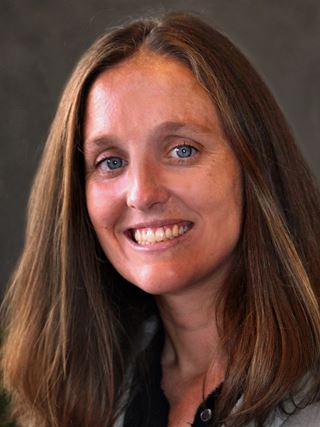 |
‘I look forward to intersecting more with the Royal Society of Chemistry and the editors and editorial board of Materials Horizons. In addition, I’m very excited to learn more about Materials Horizons and its readership. It is really a privilege to play a role in the future directions of Materials Horizons.’ |
Dr. Hatzell is an assistant professor at Princeton University in the Andlinger Center for Energy and Environment and Department of Mechanical and Aerospace engineering. Hatzell’s group primarily work on energy storage and is particularly interested at using non-equilibrium x-ray techniques to probe materials for energy and separation applications. Hatzell earned her Ph.D. in Material Science and Engineering at Drexel University, her M.S. in Mechanical Engineering from Pennsylvania State University, and her B.S./B.A. in Engineering/Economics from Swarthmore College. Hatzell’s research group works on understanding phenomena at solid|liquid, solid|gas, and solid|solid interfaces broadly work in energy storage and conversion. Hatzell is the recipient of several awards including the ORAU Powe Junior Faculty Award (2017), NSF CAREER Award (2019), ECS Toyota Young Investigator Award (2019), finalist for the BASF/Volkswagen Science in Electrochemistry Award (2019), the Nelson “Buck” Robinson award from MRS (2019), Sloan Fellowship in Chemistry (2020), and POLiS Award of Excellence for Female Researchers (2021), NASA Early Career Award (2022) and ONR Young investigator award (2023).
Please join us in welcoming Simone Fabiano and Kelsey Hatzell to the Materials Horizons Editorial Board. We encourage you to submit your best work to Simone, Kelsey and our team of Editorial board members now! Check out the Materials Horizons author guidelines for more information on our article types.
Introducing Zhongyi Jiang as a new Scientific Editor on Materials Horizons
Materials Horizons are delighted to welcome Professor Zhongyi Jiang from Tianjin University in China as a Scientific Editor.
Zhongyi Jiang is a Professor in the School of Chemical Engineering and Technology at Tianjin University. He received his PhD degree from Tianjin University (China) in 1994. He was a visiting scholar of University of Minnesota with Prof. Edward Cussler in 1997 and California Institute of Technology with Prof. David Tirrell in 2009. He is the winner of National Science Fund for Distinguished Young Scholars in China, the Cheung Kong Chair Professor and the Fellow of the Royal Society of Chemistry.
His group is interested in biomimetic and bioinspired membranes and membrane processes, biocatalysis, photocatalysis. He has co-authored over 600 publications. He is selected on the list of highly cited scholars (chemical engineering) in China and the list of highly cited scholars (chemical engineering) in the world.
Check out some of Professor Jiang’s publications in Royal Society of Chemistry journals:
Multi-stepwise electron transfer via MOF-based nanocomposites for photocatalytic ammonia synthesis
Hanjie Ren, Jiangdan Tan, Zhanfeng Zhao, Yonghui Shi, Xin Xin, Dong Yang and Zhongyi Jiang
Catal. Sci. Technol., 2022, 12, 5540-5548 DOI: 10.1039/D2CY01086K
Ultra-robust, highly proton-conductive polymer carbon dot membranes through bioinspired complexation
Benbing Shi, Xiao Pang, Hong Wu, Jianliang Shen, Jingyuan Guan, Xiaoyao Wang, Chunyang Fan, Li Cao, Tianhao Zhu, Zhuoyu Yin, Yan Kong, Yiqin Liu, Sijia Wang and Zhongyi Jiang
J. Mater. Chem. A, 2022, 10, 16995-17000 DOI: 10.1039/D2TA02460H
Multi-stepwise charge transfer via MOF@MOF/TiO2 dual-heterojunction photocatalysts towards hydrogen evolution
Yao Chen, Dong Yang, Xin Xin, Zhongshan Yang, Yuchen Gao, Yonghui Shi, Zhanfeng Zhao, Ke An, Wenjing Wang, Jiangdan Tan and Zhongyi Jiang
J. Mater. Chem. A, 2022,10, 9717-9725 DOI: 10.1039/D1TA10270B
Join us in welcoming Professor Zhongyi Jiang to our Editorial Boards!
Submit to Materials Horizons now! Check out our author guidelines for information on our article types or find out more about the advantages of publishing in a Royal Society of Chemistry journal.
Keep up to date with our latest articles, reviews, collections & more by following us on Twitter, Facebook or by signing up to our E-Alerts.
Introducing Yong Cui as a new Scientific Editor on Materials Horizons
Materials Horizons are delighted to welcome Professor Yong Cui from Shanghai Jiao Tong University in China as a Scientific Editor.
Yong Cui received his PhD in 1999 from Fujian Institute of Research on the Structure of Matter, Chinese Academy of Sciences, and conducted postdoctoral research at the University of Science and Technology of China, University of North Carolina at Chapel Hill and University of Chicago from 1999 to 2005. He joined School of Chemistry & Chemical Engineering, Shanghai Jiao Tong University in 2005, where he is now a chair professor of chemistry. He is a Fellow of the Royal Society of Chemistry. His research interest focuses on the design and synthesis of porous materials, especially frameworks materials and chiral materials, for catalysis, adsorption, separation, sensing and optics.
Read our interview with Yong below.
1. Why did you choose to specialize in your specific research field?
Nature makes pervasive use of homochirality (e.g., D-sugars and L-peptides) to assemble biomolecules, whose interactions determine life processes, while biological homochirality is still one of the major unsolved problems in science. My research interest is thus focused on the design and development of chiral crystalline materials through hierarchical self-assembly of suitably designed chiral building blocks, with the aim to fundamentally understanding how molecular-scale chirality could be significantly transmitted and amplified across differing length scales. Eventually, we aim to develop useful chiral materials with unexpected advantages relevant to materials science, molecular biology, nanotechnology and precision medicine.
2. What do you see as the biggest challenges facing researchers who work in your field?
Frankly speaking, there are lots of challenges and difficulties in this field. If I have to choose the biggest one, I think it should be how to rationally design and precisely synthesize chiral materials enabling outstanding enantioselective performance that could compare with (even beyond) natural systems.
3. What excites you most about your area of research and what has been the most exciting moment of your career so far?
One of the most exciting moments of my research was when we developed a new type of 2D materials that were achieved through exfoliation of molecule crystals. Against expectation, the free-standing homochiral monolayer crystallites rely purely on weak non-covalent forces to maintain their integrity. Our finding suggests the possibility of greatly increasing the range and diversity of 2D materials.
The most exciting moment of my career have always been related to my students who get really exciting experimental results or discover new experimental phenomena etc. I am very proud of my students who will continue to devote themself to scientific research.
4. What has been the most challenging moment of your career so far?
The most challenging moment should be the supervision of a research group, either a small or big team, but this process seems to be very rewarding. Looking back now, I was very lucky to have lots of incredible advisors, colleagues, and friends, who taught me how to be an independent scientist. I’m also grateful for working with those talented students and I really hope they have enjoyed their time in my research group.
5. Which of your Royal Society of Chemistry publications are you most proud of and why?
I would have to say that I love them all. We spend many times and make great efforts for these fundamental researches. However, if I have to select one piece of them, it would probably be the research regarding the design and synthesis of a homochiral Cr-salen-based MOF for catalysing broad-scope asymmetric transformations, including the Nazarov cyclization, aminolysis reaction, and Diels–Alder and hetero Diels–Alder reactions. This work demonstrates the superior reactivity of Cr-salen embedded crystalline porous materials, which represents an important step towards practical applications.
6. Why do you feel that researchers should choose to publish their work in Materials Horizons?
Materials Horizons is a high-profile, prestigious journal publishing rigorously peer-reviewed research across broad-scope disciplines. The high impact factor (up to 15.717) of this journal is indicative of that the editorial community are leading this journal to the cutting-edge research directions. That’s important for researchers, knowing that you are publishing your work in an ascending journal with strong reputation.
7. What attracted you to join the Editorial Board of Materials Horizons?
The editorial board of Materials Horizons has done a great job in attracting high-quality and innovative material science research. I believe that I could help to further improve the impact of Materials Horizons and help to expand the scope of readers in China. I can see this would be a golden opportunity for me to learn how to participate and promote the development of Materials Horizons and engage the communication between the editorial board and the authors. I’m very happy to work as a board member to make Materials Horizons as one of the most exciting and high impact journals.
Submit to Materials Horizons now! Check out our author guidelines for information on our article types or find out more about the advantages of publishing in a Royal Society of Chemistry journal.
Keep up to date with our latest articles, reviews, collections & more by following us on Twitter, Facebook or by signing up to our E-Alerts.
Materials Horizons welcomes Professor Guoping Chen to the Editorial Board
Materials Horizons are delighted to welcome Professor Guoping Chen from the National Institute for Materials Science in Japan to the Editorial Board as a Scientific Editor.
Guoping Chen is a Group Leader at the National Institute for Materials Science (NIMS) and a Professor at the University of Tsukuba. He received his Ph.D. from Kyoto University in 1997 majoring in polymer biomaterials and did postdoctoral research until 2000. He joined the Tissue Engineering Research Center, National Institute for Advanced Industrial Science and Technology as a Researcher in 2000 and a Senior Researcher in 2003. He moved to the Biomaterials Center, NIMS as a Senior Researcher in 2004 and was promoted to Group Leader in 2007. He served as a Principal Investigator and Unit Director of the International Center for Materials Nanoarchitectonics (MANA), NIMS from 2011 to 2017. He concurrently joined the Joint Doctoral Program in Materials Science and Engineering, University of Tsukuba as an Associate Professor in 2004 and a Professor in 2013. He is a Fellow of the Royal Society of Chemistry (FRSC, 2015), the American Institute for Medical and Biological Engineering (AIMBE, 2017) and the International Union of Societies for Biomaterials Science and Engineering (FBSE, 2020). His research focuses on biomaterials, scaffolds, biomimetic matrices, micro-patterning, surface modification, tissue engineering, regenerative medicine and nanomedicine.
Check out Guoping Chen’s lab webpage here to find out more about his research.
Guoping Chen joins the Materials Horizons Editorial Board after previously having an Associate Editor role on Journal of Materials Chemistry B and Materials Advances. To mark this transition, he has selected some outstanding recent articles and reviews on the topic of tissue engineering across Materials Horizons, Journal of Materials Chemistry B and Materials Advances. We welcome you to read this Editor’s Choice collection on tissue engineering and check out the Editorial written by Guoping Chen to introduce the collection.
Read our interview below to find out more about Guoping:
1. What attracted you to pursue a career in materials science and how did you get to where you are now?
I have been interested in almost anything since I was a kid. I could imagine something that I did not know or had never seen. Such curiosity had driven me to show more interest on materials science after entering high school. During college study, I spent a lot of time doing experiments. By doing experiments, I found materials science more and more interesting. So, I decided to enter materials science field when I entered graduate school in 1986. Since then, I have been involved in this field for more than 36 years. Now, doing scientific experiments to synthesize new materials and to discover new phenomena has become one of my interests. My curiosity and persistence have brough many benefits to my research career.
2. Why did you choose to specialize in your specific research field?
From 1994 to 1997, I did my Ph.D. study at Department of Materials Chemistry of Kyoto University majoring in biomaterials. After graduation, I got two offers. One was tissue engineering research and the other was synthesis of stimuli-responsive polymers and actuators. I chose the first one because I thought I could challenge more new things in the interdisciplinary field of materials science and biological science. So, I joined the tissue engineering research group of a national research institute. Since then, I have been enjoying working in the field.
3. What do you see as the biggest challenges facing researchers who work in your field?
Many advanced approaches have been developed for regeneration of functional tissues and organs through materials science, biomimetics, synthetic chemistry, biomechanics and cell biology. In some cases, very complicated approaches have been proposed and used. Sometimes I think the system of our body may not be as complex as we think. There may be some switches to reveal the simple way that our body uses to assemble all cells and components together into functional tissues and organs. Finding the switches and learning from the natural assembly clues to create multi-functional biomaterials and scaffolds may be the biggest challenges in my research field.
4. What do you see as the most important scientific achievement of the last decade?
I think it is CRISPR gene editing. It provides a cheap and easy way to precisely edit DNA. It is attractive for the treatment of refractory diseases such as cancer, HIV and genetic diseases.
5. What excites you most about your area of research and what has been the most exciting moment of your career so far?
Multi-functional scaffolds are amusing because they are similar to the housing where cells live. They can provide a variety of physicochemical, biological, biomechanical and therapeutic signal and factors to guide functional tissue regeneration, to maintain cellular homeostasis and to treat diseased cells. The most exciting moment for me was in 2000 when I succeeded in preparing hybrid scaffolds of biodegradable synthetic polymers and naturally derived polymers. The hybrid scaffolds have high mechanical strength and good biocompatibility and can be used for regeneration of large tissues such as large cartilage for treatment of osteoarthritic cartilage defects. The research had been introduced twice by Nature BioNews.
6. What is your favourite reaction or material, and why?
Biomimetic materials are very attractive to me. If we can mimic the compositions, structures and processes of tissue and organ development, we can more easily control cell functions and tissue regeneration.
7. The Journal of Materials Chemistry B and Materials Advances Editorial Boards are sad to see you leave but are excited for your new role. What will you miss most about being an Associate Editor on Journal of Materials Chemistry B and Materials Advances?
I’m really proud to have joined the editorial team to work for Journal of Materials Chemistry B for nine years shortly after the JMC split and to work for Materials Advances since its launch. I appreciate the strong support and help from the great team. I am very happy to have worked with all colleagues. I had a lot of happy times and good memories during the daily editorial work, the editorial board meetings in Cambridge and RSC Editors’ Symposium in London. I have had many opportunities to communicate with our authors and reviewers. I will miss them very much. I hope they will continue to support the journals by publishing their excellent research achievements in the journals and providing excellent reviewing services for the journals.
8. What attracted you to join the Editorial Board of Materials Horizons?
I often read the articles published in Materials Horizons. The high quality of the articles has given me an impression that the editorial team is always doing a great job to edit the best articles for the readers. Now I am very happy to join the team to make some contributions.
9. The Materials Horizons team are delighted to welcome you to the Editorial Board. What are you most looking forward to when acting as a Scientific Editor for the journal?
I will fully use my previous editorial experience to provide the best service to satisfy our authors and readers.
10. What is your biggest passion outside of science?
I like jogging and cooking. After my daily work, I go jogging in a park at night. It is my happiest moment because I can relax more and think of some new research ideas while enjoying the natural night view. If time permits, I also cook because cooking is like doing chemical experiments. There are raw materials, processes and final products. There are a lot of fun.
11. Why should young people study chemistry or related subjects?
Chemistry can help us to understand the essence of nature and to synthesize novel and functional compounds and materials for innovation. Chemistry is the fundamental and central science for many fields including materials science and biological science.
12. What impact do you feel that your area of research can make over the next 10 years?
Many new techniques such as biomimetics, bioprinting and hybridization have been developed for scaffold preparation and functionalization. Advanced scaffolds with more biomimetic structures and functions will be achieved for the regeneration of not only simple tissues, but also complex organs. Multi-functional scaffolds will provide synergistic effects of different therapeutic treatments and regenerative approaches.
Please join us in welcoming Professor Guoping Chen to the Materials Horizons Editorial Board. We encourage you to submit your best work to Guoping and our team of Scientific Editors now! Check out the Materials Horizons author guidelines for more information on our article types.


